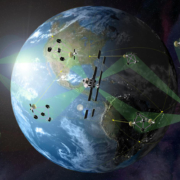DARPA Pit Boss Contractors SEAKR and SSCI Team with DARPA for Blackjack Early Risk Reduction Orbital Flights
DARPA Blackjack program prime contractors SEAKR Engineering and Scientific Systems Company, Inc. (SSCI) are preparing to use a series of small satellite demonstrations in an effort to verify and validate critical elements of the Blackjack program. In partnership with the U.S. Space Force, DARPA’s Blackjack program has an objective to ultimately launch and test a constellation of up to 20 small satellites to demonstrate critical elements of global high-speed autonomous satellite networks in Low Earth Orbit (LEO), proving a capability that could provide the Department of Defense with highly connected, resilient, and persistent overhead coverage. The first two satellites in the Blackjack constellation are scheduled for launch in late 2021. Prior to that, three SEAKR and SSCI demonstration flights, all planned as rideshare opportunities, are scheduled to begin launching in 2020. Each flight aims to verify and validate key technologies to be integrated into Blackjack satellites, to include high-speed supercomputing, optical inter-satellite links, ground software for tactical user access, satellite and constellation autonomy, and advanced processing, exploitation, and dissemination.
SEAKR Engineering is the Blackjack prime contractor for the autonomous mission system called Pit Boss. Pit Boss is an autonomous, collaborative, distributed space-based enterprise that is designed to self-task, process, and distribute tactically relevant information to manned and unmanned subscribers. The SEAKR solution includes SEAKR’s supercomputing hardware and teammate SSCI’s Collaborative Mission Autonomy Software.
As prime, SEAKR supports the Blackjack program with two risk reduction demonstration flights planned as LEO rideshares. The first demonstration, Mandrake I, delivered on a cubesat, aims to demonstrate key Pit Boss hardware and chip level technologies prior to full production. The experimental orbital platform includes a digital twin and strives for ‘real-time’ efficacy feedback on LEO radiation mitigations and processor performance.
The Mandrake II flight demonstration, a DARPA partnership with Space Development Agency, forages early technology demonstration and verification of key Blackjack mission features. Mandrake II is designed to engage laser communications between satellites and also to ground assets with Blackjack constellation laser terminals. The demonstration merits SEAKR’s forward trajectory developing state of the art space-based mesh network capabilities for Pit Boss, an integral part of the Blackjack Program.
SSCI meanwhile continues, under a Blackjack contract, to develop an early on-orbit risk reduction demonstration of Pit Boss. The mission, dubbed “Sagittarius-A*”, is planned to include technology provided by SSCI’s partners Orbit Logic, Emergent Space Technologies, Raytheon BBN, LeafLabs, Kitware, HawkEye360, and Innoflight. To get to orbit, SSCI has executed an agreement for a flight of SSCI’s Pit Boss technologies with mission service provider Loft Orbital. Loft Orbital plans to integrate the Sagittarius-A* Innoflight processor, loaded with the SSCI team’s autonomous battle management command, control, and communications (BMC3) software, onto its YAM-3 spacecraft, an ESPA-class mission hosting a number of government and commercial payloads. Loft Orbital has a unique ability to deploy missions quickly due to its Payload Hub technology, a modular, bus agnostic, and payload agnostic interface adapter that enables a plug-and-play approach to satellite missions. Loft Orbital also provides a turn-key command and control system that can be used by operators for payload operations during reserved times of the day.
The Sagittarius A* mission is intended to provide a demonstration of key initial Pit Boss BMC3 software capabilities to autonomously manage a bus and payload to satisfy a tactical user’s “mission service request” via prototype Blackjack human machine system interface (HMSI) ground software. Requested data services, in turn, are planned to be autonomously disseminated and shown on a tactically relevant user display system. The SSCI team’s open and modular BMC3 software is designed to enable on-orbit upload and host of third-party exploitation algorithms, also referred to as “massless payloads”. Multiple massless payloads are intended to be flown, all of which can operate on payload imagery data for demonstration of advanced mission capabilities. Finally, Sagittarius A* is designed to demonstrate the ability of Pit Boss to receive data products from external sources that will result in onboard autonomous tipping and cueing.
SSCI’s Vice President of Research and Development, Dr. Owen Brown, summarizes the mission’s potential: “This is incredibly exciting that SSCI’s Collaborative Mission Autonomy (CMA), further enabled by our teammate’s plug-in components and third-party massless payloads, is scheduled to ‘fly’ in space. With a successful execution of Sagittarius A*, we can complete our journey of demonstration testing CMA in all of the physical domains. The implication is that DARPA has established a technology paradigm that not only could offer BMC3 services for Proliferated LEO architectures, but that same technology could help unlock many of the capabilities required for multidomain integration of intelligent systems operating at the edge”.
About SEAKR Engineering
SEAKR Engineering is the leading-edge provider of advanced electronics for space applications. We design and manufacture processors, command and data handling systems, advanced payloads, and manned space hardware. Founded in 1982 to revolutionize spacecraft memory systems, today SEAKR continues forward innovation with state-of-the-art space communications processors capable of channelization and beamforming.
For more information on SEAKR’s processing capabilities or SEAKR products, please visit SEAKR.COM; call us at (303) 790-8499.
About Scientific Systems Company Inc.
Since 1990, Scientific Systems Company Inc. (SSCI) has been developing the brains and nervous system for manned and unmanned vehicles to operate autonomously and accomplish their missions in difficult environments for defense and commercial applications. Based in Woburn, MA, SSCI is a leading innovator in performing research and technology development for NASA and US DoD agencies. SSCI is a provider of artificial intelligence-enabled autonomous software systems for land, sea, air, and space systems, GPS-denied navigation systems, and mission planning systems. SSCI’s vision is to provide autonomy for any mission. For more information, visit www.ssci.com or contact SSCI at (781) 933-5355 or info@ssci.com.





